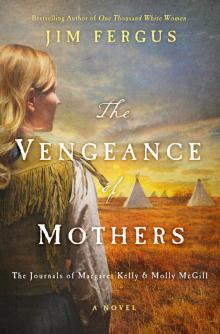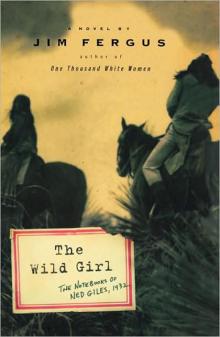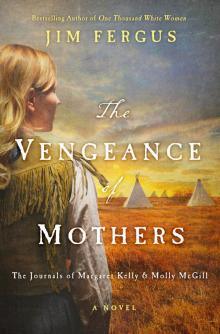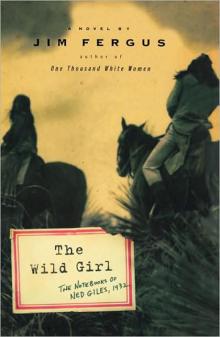- Home
- Jim Fergus
The Vengeance of Mothers
The Vengeance of Mothers Read online
Begin Reading
Table of Contents
About the Author
Copyright Page
Thank you for buying this
St. Martin’s Press ebook.
To receive special offers, bonus content,
and info on new releases and other great reads,
sign up for our newsletters.
Or visit us online at
us.macmillan.com/newslettersignup
For email updates on the author, click here.
The author and publisher have provided this e-book to you for your personal use only. You may not make this e-book publicly available in any way. Copyright infringement is against the law. If you believe the copy of this e-book you are reading infringes on the author’s copyright, please notify the publisher at: us.macmillanusa.com/piracy.
To my dear friends Moira & Jon D. Williams III,
with love
Acknowledgments
Writing and publishing a novel is a long, complicated, collaborative affair, and the author is indebted to a great number of people along the way.
I’d like to thank first my agent, Albert Zuckerman of Writers House, who has been a steadfast supporter of my work for twenty years now, as well as a wise editorial counselor and a dear friend.
After a long hiatus, I am delighted to be reunited with St. Martin’s Press. I owe the publication of my first novel, One Thousand White Women, and its continued success to my terrific editor, now Executive VP Jennifer Enderlin. I am deeply grateful to her and to President and Publisher Sally Richardson, for welcoming me back to the house so warmly and generously.
It has been my great pleasure to have worked closely on the publication of The Vengeance of Mothers with an outstanding team at St. Martin’s. My gratitude to Assistant Editor Caitlin Dareff, always prompt and gracious while serving as my liaison to the process. Thanks, too, to Production Editor Elizabeth Catalano and Production Manager Cheryl Mamaril, who are in charge of the many talented people working in the background, invariably making books better products for both author and reader. Among these are some of the anonymous unsung heroes of the business, in this case the copy editor, Amy Schneider, and the proofreader, Kenneth Diamond, who assiduously identified the typos, repetitions, anachronisms, grammatical and spelling errors, etc., making my work, finally, smoother and more literate than the original manuscript may have indicated. Virtually all authors rely on such critical service. (Having said that, I must take full responsibility if I failed to implement a few of their suggestions in the final draft.)
On other fronts of the publication grounds, my gratitude to Senior Designer Donna Noetzel and Associate Art Director Kerri Resnick for their sensitive work in making this novel both handsome and easy on the reader’s eye.
It has been an equal pleasure for me to prepare the book for launch in the marketplace with Senior Publicist Katie Bassel; Vice President of Publicity Dori Weintraub; Marketing Director Nancy Sheppard; Assistant Marketing Manager Jordan Hanley; and Vice President of Marketing, Communications Brant Janeway. I lump you all together here in the interest of brevity, but I thank you each personally for your good cheer and hard work, and for making the process so painless. I can say frankly that in my long career as a journalist and novelist, I have never worked with a more talented, capable, pleasant, and professional team from top to bottom than that at St. Martin’s Press.
Last, but certainly not least, a much overdue thanks to my old friend, Larry Yoder, who, when One Thousand White Women first came out twenty years ago, was the western sales rep for St. Martin’s Press. These fine people, too, are frequently unheralded heroes, working tirelessly in the field for low pay, driving thousands of miles a year in all weather to sell our books. I have nothing but respect and admiration for you all, not to mention gratitude. I credit much of the success of One Thousand White Women to Yoder (as everyone calls him), a legend in his profession. He embraced this first novel by an unknown, middle-aged author, and he passionately hand-sold it to booksellers across the western states. In large measure, due to his efforts on my behalf, the book won the 1998 fiction of the year award from the Mountains & Plains Independent Booksellers Association, after which it began to take on a life of its own, eventually breaking free of the stigma of “regional fiction” to find a national audience.
Their prophet, Motsé’eóve (Sweet Medicine), told the Cheyenne of the coming of a person to them; this person was apparently the white man. Sweet Medicine told the Cheyenne:
“A person is going to come to you [pl.]. He will be all sewed up [enclosed in clothes], nowhere will he not be sewed up, this person who is going to come to you. He is going to destroy for you everything that you used to depend on, he is going to destroy everything.… And this one who is going to come to you will take over all the land throughout the world.”
—excerpted from the story “Sweet Medicine”
by Mrs. Albert Hoffman in Cheyenne Texts:
An Introduction to Cheyenne Literature,
edited by Wayne Leman, 1980
In those days the country was an extra two
thousand miles wider, and an additional thousand
miles deep. There were many undiscovered valleys
to walk in where Indian tribes lived undisturbed
though some tribes chose to found new nations
in the heretofore unknown areas between the black
boundary cracks between states …
All dogs and people in free concourse
Became medium sized and brown.
—from the poem The Old Days
by Jim Harrison
It is the mothers, not the warriors, who create a people and guide their destiny.
—Luther Standing Bear,
Oglala Lakota Chief
(December 1868—February 20, 1939)
From the final entry to
The Journals of May Dodd
1 March 1876
Yes, truly it is finished now, it is over, the soldiers have come with the breaking light of dawn, like the vengeful hand of God, to strike us down. I am shot, I fear that I am dying, the village destroyed and burning, the people driven naked into the hills to crouch like animals among the rocks. I have lost track of most of the others, some still alive, some dead, I have taken refuge in a shallow cave with Feather on Head, Quiet One, and Martha. Here we huddle together with our babies as the village burns below, a huge funeral pyre upon which the soldiers pile our belongings, everything we own and all that we have—hides, furs and blankets, meat and food supplies, saddles and ammunition—and upon these piles they place the bodies of our dead, and with burning torches set all aflame, they ignite our lodges which burst into flames like trees in a forest fire, the ammunition and kegs of gunpowder inside popping and exploding like fireworks … all that we have. Gone.
I am shot, I fear that I am dying, the breath rattles in my chest, blood bubbles from my mouth and nose … as long as I have the strength, I shall continue to record these events …
from the Codicil to
The Journals of May Dodd
by Abbot Anthony of the Prairie
Saint Anthony of the Desert Abbey
Powder River, Montana
November 15, 1926
The night after the Mackenzie massacre, the mercury dipped well below zero. Everything in the Cheyenne village had been destroyed by the invading cavalry, dozens of the People slaughtered in the dawn attack—men and women, young and old, our white women and their babies among them—cut down indiscriminately by blood-crazed soldiers wielding sword, rifle, or pistol. Those who managed to survive fled into the hills, many gravely wounded, many half-dressed, with nothing to protect them or their infants from the elements. Although wou
nded seven times himself, that night the great Sweet Medicine Chief Little Wolf led the bedraggled remnants of his band across the mountains toward the village of the Lakota warrior Crazy Horse. I followed and did what little I could to aid and comfort these poor souls.
It was a ten-day journey of unimaginable hardship and suffering. Eleven Cheyenne babies froze to death in their mothers’ arms the first night, three more the following night, including all the remaining white children …
The Irish sisters, Margaret and Susan Kelly, lost both their sets of twins in the course of that brutal march. The anguish of their grief was a terrible thing to behold. They cursed me, and they cursed the Lord in his heaven for taking their baby girls.
They were a sprightly pair, Meggie and Susie. Besides Martha Atwood, they are the only white women of whom I am aware to have survived the ordeal of Mackenzie’s attack and its terrible aftermath. After the death of their infants, they went quite mad. They joined various bands of marauding Cheyenne and Sioux and fought like demons in the final days of the Plains Indian wars. They are reported to have ridden with Crazy Horse when Custer and his soldiers were killed that following summer at the Little Bighorn, and to have taken themselves grisly trophies of war there. I made many inquiries on behalf of the Kelly twins over the years and heard many rumors, but I was never able to learn what finally became of those girls. God bless them both …
Martha Atwood Tangle Hair, the sole white woman to officially survive the Mackenzie attack, returned to Chicago with her son, whose Christian name was Dodd, in honor of her dear, deceased friend May Dodd. I never saw Martha again, but for many years after we kept up a correspondence. She eventually remarried and had several more children. Except to say in her very first letter to me that she had delivered May’s final message to Captain John Bourke, Martha never mentioned the affair again—neither the Brides for Indians program, nor the devastating massacre that so definitively brought it to an end. Nor did I ever learn what arrangement she had made with the U.S. government to purchase her silence on these matters. It is not a monk’s business to ask such questions. And silent on the subject Martha remained.
PROLOGUE
by JW Dodd, III
Editor in Chief, Chitown Magazine
Chicago, Illinois
May 14, 2015
My name is Jon William Dodd, III. Most people call me JW, to distinguish me from my father, the late J. Will Dodd, known familiarly as Will. I am currently the editor in chief of the Chicago city magazine Chitown, family owned and operated, for which publication my father served in this same position for thirty-four years until his recent passing.
Some readers will remember my father as the man who discovered and published One Thousand White Women: The Journals of May Dodd in serial form in this magazine almost twenty years ago now. At the time, the journals caused quite a controversy in the academic community and were roundly denounced as fakes by outraged history professors in various universities around the country, who argued in letters to the editor that the exchange between the Cheyenne and the whites upon which they are based—that is, the trade of one thousand white women for one thousand horses—never took place, nor did there exist any historical evidence to support that claim. Although my father wrote the introduction to the series, he never directly responded to these attacks. To him, the search for and publication of the journals was a labor of love, undertaken out of a sense of familial responsibility—to learn the truth about the life and death of his great-grandmother, May Dodd; to expose the wrongs done to her by her parents; and to restore her good name in the family history. Dad never gave a damn whether the academics believed in their authenticity.
For those readers unfamiliar with her story, in the year 1875, May Dodd, age twenty-three, was abducted from her home in Chicago in the middle of the night, torn from her two young children, and committed by her parents to the Lake Forest Lunatic Asylum—all for the crime of having fallen in love with a man below her station in life. The official Dodd family history reports that she died in the asylum of undisclosed causes roughly a year later, in February 1876. However, there was an alternate, and considerably more romantic version of May’s short life: a secret family legend passed down in hushed whispers through the generations that she did not die in the asylum at all. Rather she had escaped and “gone out West to live with Indians,” a phrase that over the years had morphed into a widely used family euphemism for mental illness.
Dad’s research into this legend eventually led him to the Tongue River Indian Reservation in southeastern Montana. There in the fall of 1996, over a century and a quarter after they were written, May Dodd’s Cheyenne great-great-granddaughter, May Swallow Wild Plums, presented him with those extraordinary journals.
As a young teenager, I was fortunate enough to accompany my father on many of his travels around the Great Plains as he reconstructed May’s own journeys. I had already planned on entering the family business and to pursue a career in journalism myself, and largely due to Dad’s obsession with the subject, I had become fascinated by the native American experience—its tragic history, difficult present, and uncertain future.
Because of his familial connection to May Dodd, and his own essential decency, my father came to be received as a trusted friend on the reservation—which was not an easy accomplishment for a white man. During our numerous visits there, we camped out for weeks at a time in our Airstream trailer and became friendly with a number of tribal members. We were even invited to participate in certain sweat lodge and Sun Dance ceremonies. Although I made friends among some of the Cheyenne kids on the res, many of them maintained, quite understandably, an ingrained distrust and resentment of white people. I even got into a few fights over it.
As so often happens in this business, the publication of May Dodd’s journals was both the end of one story and the beginning of another. Abbot Anthony, known as Brother Anthony by May and her friends, was a young Benedictine monk who lived with the white women among the Cheyenne and who participated in many of the events recounted in her journals, including, of course, the fatal attack by U.S. Army cavalry troops under the command of Colonel Ranald Mackenzie on a frigid winter morning in 1876. In his codicil, written exactly a half century after that event, the abbot mentions the uncertain fates of three white women who survived that terrible ordeal—the Irish twin sisters, Meggie and Susie Kelly, and Martha Atwood, who had been employed at the Lake Forest Lunatic Asylum and who helped May escape from that ghastly institution. Although by today’s standards, such a military strike against civilians would certainly be prosecuted by the International Criminal Court as a war crime, as genocide, at the time it was unofficial, though widely accepted U.S. War Department policy, designed to exterminate the native population in order to make the Great Plains safe for the white invaders—a sadly familiar tale in the settlement of America.
Six months ago, only a few weeks before he was scheduled to retire, my father suffered a massive stroke, and three days later he died in Chicago’s Passavant Hospital. In preparation for his retirement, Dad had long been grooming me to take over the editorial reins of the magazine in order to lead it into the digital age—a largely incomprehensible and vaguely intimidating world to his generation of “print-era dinosaurs,” as he often referred to himself. I had already worked at Chitown for a number of years, starting out as a stock boy and gopher during vacations when I was still in grade school, and later on through high school, college and afterward, as a copy editor, then assistant editor, staff writer, and finally department editor.
One afternoon only ten days after my father’s death, the receptionist sent me a text message informing me that there was a young woman at the front desk asking to see me.
Name? I responded in kind.
Won’t give her name. She’s dressed weird
What kind of weird?
Like an Indian
India, or native American?
NA
What does she want?
Says she knows
you, wants to give you something. She’s carrying a pair of old leather saddlebags. I mean, like, really old
And did she ride in on a horse?
Hahaha … you want me to call security, Chief?
I told you to stop calling me that, Chloe. No, I’ll come out.
My father’s sudden death was still so recent that I was not yet comfortable sitting in his chair. In addition to my own grieving process, I had the sense of being an impostor, pretending to be editor in chief. As I passed by the other offices on my way to the front desk, I remembered coming here with Dad when I was just a boy. How different he must have found the place by the end of his career: no longer the staccato clack of typewriter keys, the jangling ring of vintage corded telephones, the cacophony of passionate journalistic conversations; no longer a haze of cigarette smoke hanging in the air like a perpetual indoor smog, or the acrid smell of burnt coffee left too long on the hot plate. Now the office was oddly quiet and sterilely clean, our young editorial staff sequestered in their glass cubicles, agile fingers drifting effortlessly over the silent keys of their various devices, the only muffled sounds the tiny electronic bells and beeps, clicks and clanks, the little whooshes as messages tumbled into their respective in-boxes.
At the front desk, I was suddenly taken out of my nostalgic reverie, indeed out of the digital age altogether, by the sight of the young woman standing before me.
Noting my surprise, the receptionist, Chloe, smiled smugly. “Told you so, Chief,” she said softly.
“Good afternoon,” I said to the woman, who did not look familiar to me. I held out my hand. “I’m JW Dodd. You wanted to see me?”
She looked at my hand but did not take it. “In private,” she answered.
“May I ask what this visit is in reference to?”

 La Vengeance des mères
La Vengeance des mères The Wild Girl: The Notebooks of Ned Giles, 1932
The Wild Girl: The Notebooks of Ned Giles, 1932 One Thousand White Women
One Thousand White Women One Thousand White Women: The Journals of May Dodd
One Thousand White Women: The Journals of May Dodd Chrysis
Chrysis Strongheart: The Lost Journals of May Dodd and Molly McGill
Strongheart: The Lost Journals of May Dodd and Molly McGill The Vengeance of Mothers
The Vengeance of Mothers The Wild Girl
The Wild Girl